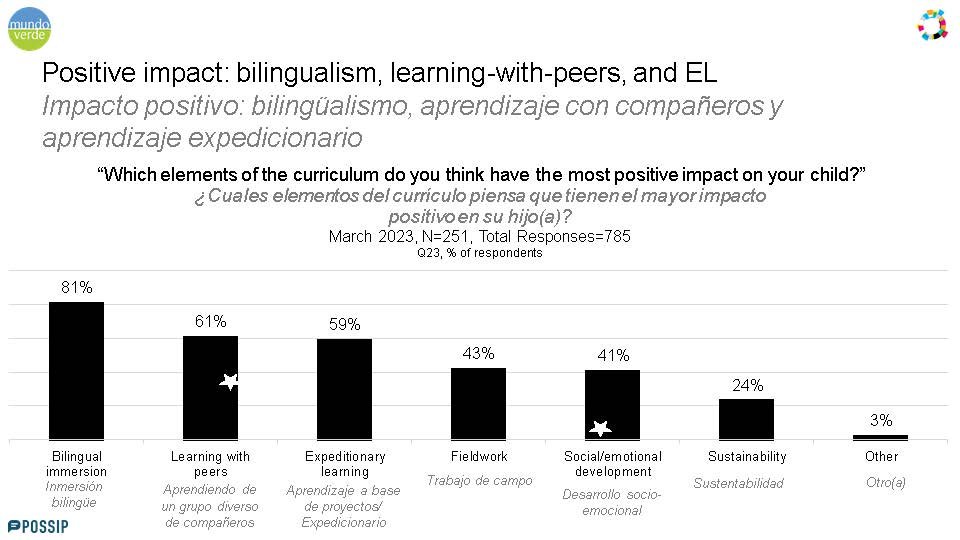Based on recent, monthly “pulse” surveys conducted in collaboration with Possip, as well as results from our in-depth spring survey of the parent/caregiver community, this blog highlights core findings related to belonging, enrollment, expectations, participation, involvement, communications, and race.
But first, to clarify any misunderstandings about how and why we do this research, a few methodological notes are in order. First, while the number and demographic characteristics of respondents to any one survey can be indicative of the larger community, they are not statistically representative. That said, detailed analysis of respondent demographics over time with actual school demographics do show a very high degree of alignment (and also enable us to see where respondents might be over- or under-represented.) Second, some questions (and answer sets) are intentionally framed narrowly so that school leaders can learn how respondents are thinking and feeling about specific school activities or priorities. This is neither inadvertent nor manipulative but rather an explicit means of assessing community attitudes and values. On the other hand, broad and/or open-ended questions are also posed to ensure that we also capture opinions and views beyond what might already be in the purview of school leadership.
Using these and other well-tested survey research techniques, we thus now know that between 67% and 90% of respondents feel a sense of belonging. As can be seen below, this broad sense of feeling a part of the community has been remarkably consistent for 10 years.
Similarly, 92% of respondents indicate that bilingual immersion was the primary reason for enrolling at Mundo Verde -- with the relationship with DCI, diversity, location, and reputation each drawing roughly the same percent of respondents as the primary reasons for much smaller groups of respondents.
Notably, related to fundamental pillars of the school that do not seem to be major drivers of enrollment, respondents come from experience to value the positive impact of such as EL (expeditionary learning), learning with peers, social/emotional development, and sustainability.
More broadly related to expectations overall, ~60% of respondent across all major ethnic/racial cohorts report that “Mundo Verde has met my expectations.”
Among respondents who report that their expectations have not been met, the top three areas identified for adjustments are indicated below: academic focus, staffing stability, firmer approaches to bullying and security.
Beyond views on enrollment and expectations, the chart below shows how, in practice, respondents participate in the community. As is also clear below, there are significant differences in participation across racial/ethnic groups - some of which are noted with stars:
To build an even more robust understanding of how the community see involvement, we also posed that as a direct question -- and then examined satisfaction with diverse levels of involvement. As indicated below, two-thirds of respondents describe themselves as being quite a lot, a lot, or somewhat involved; an additional 25% see themselves as a little involved. Thirteen percent feel not much involved. Across this full spectrum of involvement, please note from the pie chart on the right below that 62% are content with the extent of their involvement.
The extent of that satisfaction, however, is not evenly reflected across ethnic/racial cohorts. For example, 46% of Black respondents would like to be more involved compared to 29% of White respondents.
Examining the flip side of parental/caregiver involvement with the school, we have also examined the school’s outgoing communications with parents/caregivers. As seen below, a majority of responses show that (56%) would like communications more “streamlined,” while 42% are seeking more detail, 25% want materials sent more quickly, and 19% of responses favor greater frequency. In its ongoing efforts to meet everyone’s needs, the school will continue to balance the desire for streamlined communications with the desire for more details, more quickly, and more frequent.
An additional aspect of both involvement and communications was also examined in the Spring Survey. Opinions are dispersed across a range of issues, from carline to staffing, as indicated below.
As noted above, opinions are not always consistent across ethnic/racial cohorts. At a school that is diverse by design, this may not come as a surprise. But as a community it is profoundly important. We thus asked a battery of questions about race that provide us with a baseline moving forward. While complex and sensitive, unravelling views and experiences about race are fundamental to ensuring that all students are served equally well during their time at Mundo Verde. The chart below contains a lot of information. And note, please that the right-hand bar graph is from March 2022. Among the many things it shows us, one jumps out.
While essential, being “aware” of race and racism, and even assessing its impact on “student success” at Mundo Verde, are both profoundly different from the actual “experience” of prejudice. A challenge that goes well beyond the walls of the school, awareness alone is not enough.
If you have questions or would like to discuss these findings, please contact the schools strategy and communications consultant, Jonathan Halperin: jhalperin@mundoverdepcs.org








